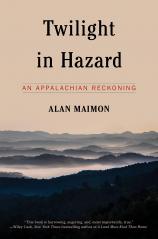Interview: June 11, 2021
TWILIGHT IN HAZARD is investigative reporter and Pulitzer Prize finalist Alan Maimon’s troubling account of how a perfect storm of events made a devastating impact on the residents in small Appalachian towns --- a case of severe and accelerating rural distress that, over the past 20 years, has expanded to send tremors through the rest of America. In this interview conducted by Michael Barson, Senior Publicity Executive at Melville House, Maimon talks about the challenges he faced when he was assigned to report on life in rural Eastern Kentucky following a two-year stint at the New York Times’s Berlin bureau, the urgent need to demystify the region so it can be understood by the rest of the country, and the possibility of income-generating hope on the horizon.
Question: In 2000, you returned from a two-year stint at the New York Times’s Berlin bureau to apply for a job with the Louisville Courier-Journal, which required you to embed yourself as their investigative reporter in the Eastern Kentucky region centered in Hazard. So you had to begin a new life in an area you had never even seen before, let alone lived in. Which adjustment pressures were most problematic for you in those early months?
Alan Maimon: I had experienced quite a few frigid, gray Berlin winters, so I was mentally prepared for just about anything that Eastern Kentucky threw at me during those cold and challenging first months. The biggest adjustment pressure was getting up to speed on the most important issues facing the region and developing the expertise and sources needed to write about those issues. There were a lot of 12- and 14-hour days in those early months as I covered the first institutional responses to the opioid epidemic, the aftermath of a massive environmental disaster in Martin County, Kentucky, and an assortment of other stories that ended up impacting the region for a long time to come.
Q: You mention that you are the last reporter from a major newspaper to have been assigned to cover the Eastern Kentucky region full-time. If that is true, how can any progress --- or lack thereof --- in solving what you identify as the most critical problems afflicting the region be tracked in 2021?
AM: The good news is that the Lexington, Kentucky newspaper still has a presence in Eastern Kentucky, albeit a lesser one than it did back when I covered the region. My former paper, the Courier-Journal, only occasionally sends reporters to Eastern Kentucky, usually to cover major breaking news. The Associated Press has also closed its Appalachian Kentucky bureau. All of this leaves a void that is difficult to fill. There is certainly value in national news outlets dispatching reporters to the region, but that type of parachute journalism can't take the place of intensive day-in, day-out coverage of an area, especially one at as much of a crossroads as Eastern Kentucky. What ends up happening is that a lot of important stories go untold, and we lose out on gaining a textured and nuanced view of a place.
Q: When you speak of the urgent need to demystify Eastern Kentucky so it can be understood by the rest of the country, can you first identify the agencies whom you consider most responsible for creating and propagating those myths in the first place?
AM: Eastern Kentucky has always held an unexalted place in the public imagination. That's due in large part to its troubled economic history, but it's also a result of how the region has been portrayed in mass media, whether it be Hollywood films, network news reports, or yes, books. Those of us who covered the region on a daily basis had an opportunity to provide a fuller picture of the region, and I've thought a lot about how I depicted Eastern Kentucky in my stories. There was a lot of troubling news coming out of the region at the time, and my dispatches painted a fairly bleak picture of life there. There is no getting around the fact that these stories are fundamental to understanding Eastern Kentucky, but what I've tried to do in this book is provide context to those stories, as well as an assessment of their meaning within the framework of the area's generational struggles.
Q: While you were embedded in Hazard between 2001 and 2005, you met your wife to be, whose father had been a coal miner. Were there times when she was able to steer you onto a path that a story required that you might not have solved on your own?
AM: My wife has on many occasions served as an unofficial guide and cultural liaison. She has helped keep me aware of the latest news and trends in Eastern Kentucky, and Harlan County in particular, where she was born and raised. One thing she's helped me understand is the vastness of the Appalachian diaspora. Her Facebook page is filled with childhood friends who are now scattered around the country. Some of them are doing really impressive things. She has also reminded me not to lose sight of the tremendous sense of community that exists in many corners of Eastern Kentucky.
Q: The rural poverty that has afflicted this region so severely since the collapse of the coal industry needs an infusion of a new business to help it recover. But what might that be? You point out that the “Silicon Holler” phase of hoping that Sykes info tech might be the savior flamed out after a few years. Is there any other income-generating hope on the horizon?
AM: Eastern Kentucky's leaders have long talked about the need to diversify the area's coal-based economy, but those conversations have historically lacked a necessary sense of urgency. In 2021, I think the area's economic development officials have finally recognized that coal isn't coming back this time. They've become more serious about working towards creating a multi-faceted economic transition. That in and of itself is a sign of progress. With the right vision and leadership, there are some exciting things that could happen in Eastern Kentucky. The uniqueness of the region can be a strength rather than a weakness. The outdoor recreation industry has the potential to thrive. There are a lot of small and charming downtowns waiting to be revitalized. Eastern Kentucky has the potential to lure much-needed private investment, but it can't afford to fall prey again to companies that move in to take advantage of tax incentives and then close shop once those incentives run out.
Q: In the book you identify Eastern Kentucky as “a proxy for struggling regions everywhere.” But finding the key to reversing the Persistent Poverty syndrome has eluded every effort to this point. If Joe Biden appointed a committee dedicated to rectifying this issue, what would be the first actions you’d like to see taken?
AM: It is true that ever since President Lyndon Johnson came to Eastern Kentucky in 1964 to launch his "War on Poverty," government has struggled to reverse the area's persistent poverty. One of the impediments to progress has been corrupt local rule. Government alone was never going to be able to turn around the fortunes of Appalachian Kentucky, but there is certainly a role for the public sector to play in the process. I like the idea of a Marshall Plan for coal country that Illinois Senator Tammy Duckworth introduced in Congress in 2020. It would give the area the immediate jolt of stimulus that it needs while longer-term strategies for economic development get fleshed out and implemented. I'd like to see President Biden get behind that plan.




